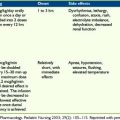13 The Interface of Ethics and Palliative Care
Ethics committees and consultation in pediatrics are both relatively recent phenomena. In the 1970s, only a few hospitals had ethics committees.1 By the end of the 1980s, most hospitals did. The stimulus for the development of ethics committees was the Baby Doe controversy of the early 1980s in which a baby with Down syndrome and esophageal atresia was allowed to die without routine surgery. This led the federal government to promulgate controversial guidelines for end-of-life decisions, guidelines that were challenged and eventually struck down by the U.S. Supreme Court.2 In the aftermath of that controversy, the American Academy of Pediatrics (AAP) formed a task force to define the role of ethics committees.3 The early committees focused almost exclusively on newborns and the controversies surrounding decisions to withhold or withdraw life-sustaining treatment. Later, ethics committees broadened the scope of their concerns.
Over the years, ethics committees and consultants have taken on more diverse roles. They broadened their mandates to include children of any age.4 Some even began considering cases involving fetuses and perinatal decisions.5 They also broadened the scope of their concern from clinical decisions to cases involving organizational ethics.6 Organizational issues of concern include matters of informal organizational culture, especially when that informal culture leads to practices that conflict with organizational policy, communication problems, and issues of resource allocation that are built into but not explicitly addressed by organizational policy.7
Pediatric palliative care programs developed over the same time period as pediatric bioethics committees. Their development was not fueled by a political controversy so they had a somewhat slower start.8 The field of palliative care gained legitimacy with the creation of a national board of hospice and palliative care medicine in 1995.9 In 2003, the Institute of Medicine report “When Children Die,” helped define the field of pediatric palliative care.10 The first freestanding pediatric hospice and respite care facility, the George Mark Children’s House, opened in California in 2003.
The Overlapping Domains of Bioethics and Palliative Care
The Nature of the Work
The care of children with life-threatening illnesses is a moral experiment. We keep children alive today who have conditions that, until just a few decades ago, were routinely fatal. Our technologic ability has now reached the point where there are very few conditions that can be unambiguously deemed to be incompatible with life.11 These technologies allow us to take children and their families into domains where, to paraphrase science fiction, nobody has ever gone before.
We are beginning to map out those worlds. The maps are no doubt imperfect, as are the maps of all early explorers. We are beginning to understand the long-term outcomes for premature babies born at various gestational ages,12 and to refine our prognostic estimates using other medical and demographic factors.13 We are beginning to learn how to have conversations with parents in which we both deliver bad news and try to help them understand the choices that must be made.14 We are beginning to understand a bit more about parents’ experiences when faced with such choices.15,16 We are untangling some of the quirky contradictions in the way both clinicians and families think about particular choices.17
The Future
These coming changes to pediatrics will challenge the process by which parents and doctors make decisions together. We are just starting to understand how parents deal with these challenges. Payot, et al, have described the differences between parents and neonatologists facing decisions about resuscitation.18 They write, “While neonatologists focus on the management of the unborn baby, parents have yet to fully conceptualize their infant as a distinct entity since they are in a process of grieving their pregnancy and their parenthood project.” Hinds and colleagues analyzed a similar phenomenon in parents of children with cancer.19 Although it was important to parents to make “informed, unselfish decisions in the child’s best interest,” it was equally important for them to “remain at the child’s side, show the child that he is cherished, teach the child to make good decisions, advocate for the child with the staff, and promote the child’s health.” Parents are and want to be active participants in their child’s care and in the decisions that are made about that care. Many do not see a sharp distinction between palliative care and life-prolonging care. They want both. They don’t want to choose. They want them to be seamlessly intertwined.20 Some parents reject any discussion of palliative care or the withholding of life-prolonging treatment.21 The lessons that we’ve learned allow us to speculate about the future of the interface between pediatric palliative care and pediatric bioethics.
Three types of situations increasingly present occasions for collaboration between bioethics and palliative care. The first is in the management of conditions in which death is inevitable in a relatively short period of time. Such situations include metastatic cancer for which there is no further chemotherapy, multisystem organ failure in patients who are not candidates for transplantation, or degenerative metabolic diseases for which there is no curative therapy. In those cases, questions arise more and more frequently about the boundaries between appropriate palliative care and euthanasia. Such questions have already been raised in other countries and in other age groups. In the Netherlands, for example, the Groningen protocol defines certain conditions for which euthanasia is permissible.22 The protocol has led to much debate,23 which will continue and intensify.24 In particular, controversies arise in the gray zone between active euthanasia and intensive palliative sedation at the end of life.25
A third situation is that in which better symptom management and better analgesia make it more acceptable to continue intensive and burdensome life-prolonging treatments. We commonly see this in oncology, surgery, and intensive care. Better management of pain and symptoms allows for more intensive care in the PICU. As Stoddard and colleagues noted, “Treating children who are critically ill with psychotropic drugs is an integral component of comprehensive pediatric critical care in relieving pain and delirium; reducing inattention or agitation or aggressive behavior; relieving acute stress, anxiety, or depression; and improving sleep and nutrition.”26 Better management of surgical and post-operative pain allows children to undergo many surgical procedures. Better symptom management in oncology allows more disease-directed chemotherapy. In all these cases, palliative care specialists may find themselves facing new sorts of ethical dilemmas.
Examples of ethical issues in palliative care
A few cases illustrate how this works in practice:
What, exactly, do ethics consultants do when asked to consult on such cases? Generally, they use a number of well-established frameworks for ethics consultation in order to clarify the ethical dilemmas and to develop permissible responses. One such framework was developed by McCullough and Ashton.27 They ask the following questions:
An alternative four- box approach was developed by Jonsen, Siegler, and Winslade. Their four boxes are: medical indications, patient preferences, quality of life, and external factors.28 In their book, Clinical Ethics, they argue that these four boxes provide a framework for identifying and resolving moral conflicts in particular cases.
1 Michaels R.H., Oliver T.K.Jr. Human rights consultation: a 12-year experience of a pediatric bioethics committee. Pediatrics. 1986;78:566-572.
2 Mahowald M.B. Baby Doe committees: a critical evaluation. Clin Perinatol. 1988;15:789-800.
3 American Academy of Pediatrics Infant Bioethics Task Force and Consultants. Guidelines for infant bioethics committees. Pediatrics. 1984;74:306-310.
4 Mitchell C., Truog R.D. From the files of a pediatric ethics committee. J Clin Ethics. 2000;11:112-120.
5 Bliton M.J. Ethics: “life before birth” and moral complexity in maternal-fetal surgery for spina bifida. Clin Perinatol. 2003;30(3):449-464.
6 Opel D.J., Wilfond B.S., Brownstein D., et al. Characterisation of organisational issues in paediatric clinical ethics consultation: a qualitative study. J Med Ethics. 2009;35:477-482.
7 Magnus D. Organizational needs versus ethics committee practice. Am J Bioeth. 2009;9:1-2.
8 Corr C.A., Corr D.M. What is pediatric hospice care? Child Health Care. 1988;17:1.
9 von Gunten C.F., Sloan P.A., Portenoy R.K., Schonwetter R.S. Trustees of the American Board of Hospice and Palliative Medicine. Physician board certification in hospice and palliative medicine. J Palliat Med. 2000;3(4):441-447.
10 Institute of Medicine. When children die: improving palliative and end-of-life care for children and their families. 2003. National Academies Press: Washington, DC. www.nap.edu/catalog.php?record_id=10390. Accessed May 17, 2010.
11 Koogler T.K., Wilfond B.S., Ross L.F. Lethal language, lethal decisions. Hastings Cent Rep. 2003;33(2):37-41.
12 Johnson S., Fawke J., Hennessy E., et al. Neurodevelopmental disability through 11 years of age in children born before 26 weeks of gestation. Pediatrics. 2009;124(2):e249-e257.
13 Tyson J.E., Parikh N.A., Langer J., Green C., Higgins R.D. National Institute of Child Health and Human Development Neonatal Research Network: Intensive care for extreme prematurity: moving beyond gestational age. N Engl J Med. 2008;358:1672-1681.
14 Meyer E.C., Sellers D.E., Browning D.M., et al. Difficult conversations: improving communication skills and relational abilities in health care. Pediatr Crit Care Med. 2009;10(3):352-359.
15 Forman V. This Lovely Life. Mariner Books, 2000.
16 Farlow B. Misgivings. Hastings Cent Rep. 2009;39(5):19-21.
17 Janvier A., Leblanc I., Barrington K.J. The best-interest standard is not applied for neonatal resuscitation decisions. Pediatrics. 2008;121(5):963-969.
18 Payot A., Gendron S., Lefebvre F., et al. Deciding to resuscitate extremely premature babies: how do parents and neonatologists engage in the decision? Soc Sci Med. 2007;64(7):1487-1500.
19 Hinds P.S., Oakes L.L., Hicks J., et al. “Trying to be a good parent” as defined by interviews with parents who made phase I, terminal care, and resuscitation decisions for their children. J Clin Oncol. 2009;27(35):5979-5985.
20 Mack J.W., Wolfe J. Early integration of pediatric palliative care: for some children, palliative care starts at diagnosis. Curr Opin Pediatr. 2006;18(1):10-14.
21 Baergen R. How hopeful is too hopeful? Responding to unreasonably optimistic parents. Pediatr Nurs. 2006;32(5):482. 485–486
22 Verhagen E., Sauer P.J. The Groningen protocol: euthanasia in severely ill newborns. N Engl J Med. 2005;352:959-962.
23 Lindemann H., Verkerk M. Ending the life of a newborn: the Groningen Protocol. Hastings Cent Rep. 2008;38(1):42-51.
24 Manninen B.A. A case for justified non-voluntary active euthanasia: exploring the ethics of the Groningen Protocol. J Med Ethics. 2006;32:643-651.
25 Postovsky S., Moaed B., Krivoy E., et al. Practice of palliative sedation in children with brain tumors and sarcomas at the end of life. Pediatr Hematol Oncol. 2007;24(6):409-415.
26 Stoddard F.J., Usher C.T., Abrams A.N. Psychopharmacology in pediatric critical care. Child Adolesc Psychiatr Clin North Am. 2006;15(3):611-655.
27 McCullough L.B., Ashton C.M. A methodology for teaching ethics in the clinical setting. Theoretical Med. 1994;15:39-52.
28 Jonsen A., Siegler M., Winslade W. Clinical ethics: a practical approach to ethical decisions in clinical medicine. MacGraw Hill, 2006.





